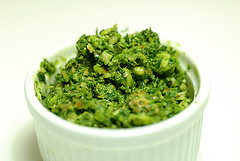An eclectic November collection
 Tuesday, November 24, 2009
Tuesday, November 24, 2009 Confession time: For the past 3 weeks, I've been feeling twinges of guilt and anxiety every time I see Greens & Berries in my web browser's toolbar. Yes, my blog. I've been avoiding it. Until earlier today.
You see, I've convinced myself I don't have enough uninterrupted time for writing and publishing posts on a regular schedule. Inspiration has been hiding, too, perhaps behind the heavy, grey November clouds. Or more likely, she's gone south, looking for sunshine. I would if I could.
That said, reviewing, organizing and annotating Web links don't require inspiration. Just self-discipline and a couple of focused hours, which -- amazingly -- I had this morning between 10 and noon!
Here's a sample of November's additions to my Connotea (clinical nutrition) and Delicious (food and all other interests) bookmarks.
Applying nutrition science
- If you don't have time to read every article or abstract in the latest issue of the American Journal of Clinical Nutrition, you can keep up with nutrition research by checking out the highlights page and 50 Most-Frequently Read Articles.
- Leslie Beck, RD, on her web site and in her weekly Globe and Mail column, translates the latest nutrition science into practical guidelines. Recently she provided timely tips on how to boost your immune system with the right foods and supplements.
- New York Times health writer Jane E. Brody explores and clearly, succinctly explains how a low-acid diet promotes bone health. If you're interested in reading other studies, you can find them listed in a post I published earlier this month: Nutrition & Bone Health: How to build & maintain healthy bones on a plant-based diet
- Are Vegetarian Diets OK? - In her typical, no-nonsense style, Marion Nestle says "yes", which is no surprise. But I'd encourage you to read beyond Dr. Nestle's post for evidence-based and ethical reasons why they're more than "ok" for humans (adults AND children), animals and the environment.
For example, two of my trusted sources are the Vegetarian Resource Group (look for articles by Reed Mangels, Ph.D, RD) & The Vegan Dietitian (Virginia Messina, MPH, RD.) Also, in May 2009 the American Journal of Clinical Nutrition published a supplement on the 5th International Congress on Vegetarian Nutrition.
Writing with integrity
Avoiding plagiarism, self-plagiarism, and other questionable writing practices: A guide to ethical writing (PDF) - Even though I'm not writing my own research now or in the foreseeable future, I'll be applying these guidelines to blog posts where I summarize study results.
Nourishing the senses
These past two weeks there have been many posts and tweets about Vegetarian and Vegan Thanksgiving recipes and I'm not going to repeat them here. However, I'd be remiss if I didn't share this one, my pick for the most elegant meal I've seen on any blog this year: chef and writer Viviane Bauquet Farre's Vegetarian Thanksgiving Feast.
Nourishing the spirit
And one evening, at the end of a day heavy and dark with rain, I found the perfect poem for the moment:
Then too there is this
joy in the day's being done, however
clumsily, and in the ticked-off lists....(you can read the rest of the poem here)
And let me add there is also joy (!) in this post's being done, however clumsily.
Thank you for reading. I hope you find something in this post to help you get through your day with greater knowledge, better health, and deeper commitment to doing your best work in all things.

